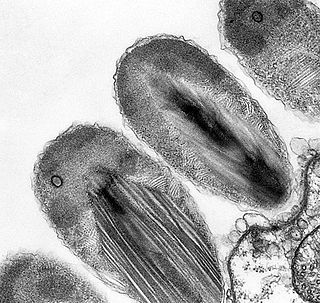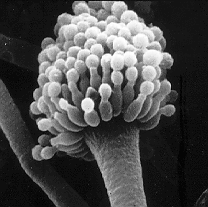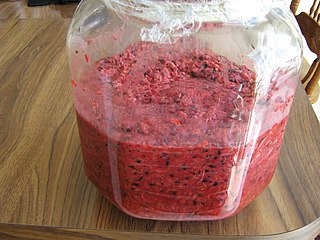
A spirochaete or spirochete is a member of the phylum Spirochaetota, which contains distinctive diderm (double-membrane) Gram-negative bacteria, most of which have long, helically coiled cells. Spirochaetes are chemoheterotrophic in nature, with lengths between 3 and 500 μm and diameters around 0.09 to at least 3 μm.

Verrucomicrobiota is a phylum of Gram-negative bacteria that contains only a few described species. The species identified have been isolated from fresh water, marine and soil environments and human faeces. A number of as-yet uncultivated species have been identified in association with eukaryotic hosts including extrusive explosive ectosymbionts of protists and endosymbionts of nematodes from genus Xiphinema, residing in their gametes. The verrucomicrobial bacterium Akkermansia muciniphila is a human intestinal symbiotic bacterium that is considered as a promising probiotic.
The Eubacteriales are an order of bacteria placed within the class Clostridia.

The Eurotiales are an order of sac fungi, also known as the green and blue molds. It was circumscribed in 1980.

Condé Benoist Pallen was an American Catholic editor and author. He was editor of Church Progress and the Catholic World from 1887 to 1897. He was managing editor of the Catholic Encyclopedia from 1904 to 1920. He wrote essays, poetry, and novels.

Red yeast rice, red rice koji, red fermented rice, red kojic rice, red koji rice, anka, or angkak, is a bright reddish purple fermented rice, which acquires its color from being cultivated with the mold Monascus purpureus. Red yeast rice is what is referred to as a "koji" in Japanese, meaning "grain or bean overgrown with a mold culture", a food preparation tradition going back to ca. 300 BC. In both the scientific and popular literature in English that draws principally on Japanese traditional use, red yeast rice is most often referred to as "red rice koji." English language articles favoring Chinese literature sources prefer the translation "red yeast rice."

Monascus purpureus is a species of mold that is purplish-red in color. It is also known by the names ang-khak rice mold, corn silage mold, maize silage mold, and rice kernel discoloration.

Monascus is a genus of mold. Among the known species of this genus, the red-pigmented Monascus purpureus is among the most important because of its use in the production of certain fermented foods in East Asia, particularly China and Japan.
The Panda's Thumb is a blog on issues of creationism and evolution from a mainstream scientific perspective. In 2006, Nature listed it as one of the top five science blogs, and Mark Pallen has called it "the definitive blog on the evolution versus creationism debate".

The mangrove vireo is a species of bird in the family Vireonidae.

DXN is an international company based in Malaysia. Founded in 1993 by Datuk Dr. Lim Siow Jin, DXN manufactures and markets dietary supplements containing the mushrooms Ganoderma or Lingzhi. DXN products are marketed by affiliated companies Daehsan, Ltd. and Daxen in some countries in Europe and Asia.

Allium pallens is a species of wild onion native to the Mediterranean region and Middle East from Portugal and Algeria to Iran.
Monascus kaoliang is a fungus.
Mark J. Pallen is a research leader at the Quadram Institute and Professor of Microbial Genomics at the University of East Anglia. In recent years, he has been at the forefront of efforts to apply next-generation sequencing to problems in microbiology and ancient DNA research.

Monascus sanguineus is a fungal species in the family Aspergillaceae. It was found during a survey done on water and sediment of river Shatt al-Arab at Basra city, southern Iraq. The research was done by Basil Abbas under supervision of S.K. Abdullah in 1995.

Huangjiu is a type of Chinese rice wine most popular in the Jiangnan area. Huangjiu is brewed by mixing steamed grains including rice, glutinous rice or millet with qū as starter culture, followed by saccharification and fermentation at around 13–18 °C (55–64 °F) for fortnights. Its alcohol content is typically 8% to 20%.
Monascaceae is a former family of fungi in the subclass Eurotiomycetidae.

Orchis pallens, the pale orchid or pale-flowered orchid, is a perennial herbaceous plant belonging to the genus Orchis of the family Orchidaceae. It is found in most of Europe ranging from Spain across to the Caucasus. It blooms in spring with pale yellow flowers.

Hypericum pallens, commonly known as the Pale St. John's wort or Mount Lebanon St. John's wort, is a species of flowering plant in the family Hypericaceae which is found in Turkey, Lebanon, and Syria.













